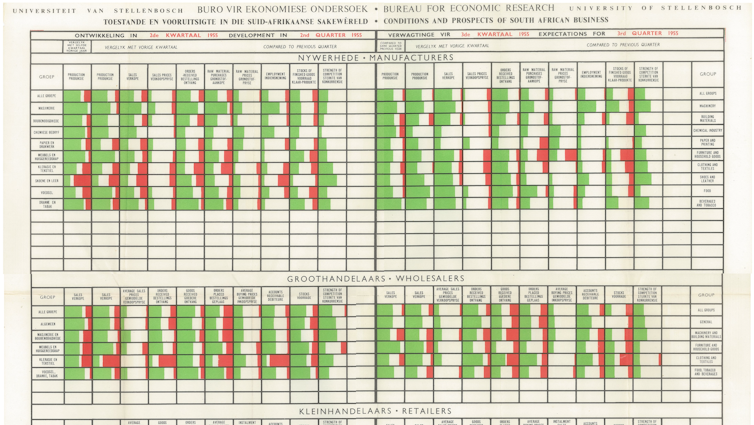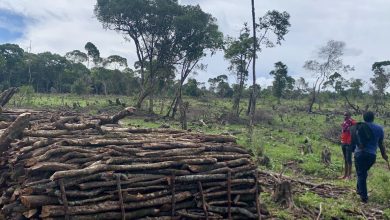how a 70-year-old survey has given early signals of the economy’s pulse

مجلة المذنب نت متابعات عالمية:
Business tendency surveys provide very useful indicators of trends within an economy. The information is available well before the official statistics, such as GDP growth, and provides insights into business dynamics that cannot be found elsewhere.
For 70 years the Bureau for Economic Research at South Africa’s Stellenbosch University has been conducting business tendency surveys. Indeed, South Africa remains one of the few countries where these surveys are conducted by a non-state agency.
The surveys cover a range of questions, tracking everything from activity to demand, selling prices to inventories, investment and also the constraints holding back investment. But the most important question is very simple: are you satisfied with prevailing business conditions? Respondents can only respond with a yes or a no. There is no scale, no maybe, no but. It is a pure gut feeling. This is the only true measure of business sentiment in South Africa.
While it can be argued that at times of fast production growth sentiment is more upbeat (and vice versa during a recession), sentiment typically turns before you see production growth. Respondents to Bureau for Economic Research surveys know their business like the palm of their hand. They sense when something starts changing and know when they can turn cautiously optimistic about conditions even though activity is not there (yet). As illustrated in the figure below, confidence often turns before the business cycle phase changes from an upward to a downward phase (and the other way around).
Changes in sentiment tell us a lot about investment intentions, as well as the potential for faster economic growth and job creation in the economy. If business people in South Africa are downbeat about business conditions, it is near impossible to see growth accelerate. Why build a new factory or employ workers if you are not, at the very least, satisfied with the environment you have to operate in today?
While the survey process has changed over the past seven decades, the value of the insights has not. South Africa’s new government of national unity has promised to tackle the country’s structural constraints, with reforms aimed at improving electricity, infrastructure, water and logistics. By providing a reliable measure of sentiment, the survey will go a long way in assessing whether they are successful.
Business confidence ahead of economic shifts
While we survey a range of sectors, only the responses of a specific set of sectors are compiled into the so-called composite Business Confidence Index. This index is sponsored by Rand Merchant Bank (RMB) and is known as the RMB/BER BCI.
The index looks at the responses of manufacturers, retailers, wholesalers, new vehicle dealers and main building contractors. These sectors represent the productive sectors of the economy and tend to lead the rest of the economy.
So, if something changes here, one can be fairly sure that it will soon start changing in the rest of the economy. Manufacturers, for example, have a feel for both domestic and export demand conditions, which later trickle through the rest of the economy. New vehicle dealers will be the first to know when local consumers start holding their purse strings.
In most sectors the survey also asks respondents about constraints to business conditions. We ask the same set of questions each quarter and have been doing so for decades. This gives us a very powerful, long-term time series of data. For example, over the last ten years, manufacturers have almost consistently seen the general political climate as the most serious constraint on business conditions.
The Absa Manufacturing Survey shows that it’s a more serious constraint than insufficient demand or the short-term interest rate, despite the latter being at the highest level in 15 years. Interestingly, the political climate constraint fell sharply in the third quarter of 2024, following the formation of the government of national unity. The disruptions at local ports were also picked up by our surveys, with load-shedding top of mind for many respondents in 2023 (and before).
The graph below shows a long-term series of business confidence. A reading of 100 would signal extreme optimism with every respondent satisfied with business conditions – this has never happened before. A reading of zero means not a single respondent is satisfied with business conditions. This, too, has not happened before, but we did see confidence fall to just 5 index points in the second quarter of 2020, the worst of the COVID-19 lockdowns, with many businesses forced to close temporarily. The BER surveys provided invaluable information about business dynamics in the formal economy during the pandemic and the recovery.
Figure 1: RMB/BER Business Confidence Index (BCI)
Source: BER. Note, business cycle downswing phases as determined by the South African Reserve Bank are shaded.
The RMB/BER BCI edged up by three index points to 38 in the third quarter of 2024. This was the first survey after the formation of the new government, and some may have hoped for a bigger boost to sentiment. Still, underlying results suggest respondents are turning cautiously more optimistic about the future. For the first time since early 2022, most respondents across the different sectors expect business conditions to improve in 12 months’ time, instead of deteriorating (further).
Current demand conditions, however, remained tough, which held back a bigger recovery in sentiment.
A firm commitment by the new government of national unity to continue with structural reform aimed at alleviating the constraints on the South African economy and an effort to bring down the cost of doing business (by lowering the administrative burden, for example) would go a long way in supporting a more pronounced recovery in business confidence.
Higher confidence will translate into faster economic growth over time.
How the index is compiled
Taking a step back, in 1954, and for many decades after that, everything at the BER was done by hand. The surveys were sent by post, and indices were painstakingly calculated as the responses trickled in. Some graphs were even drawn up by hand. Over time, more electronics became involved. South African postal services deteriorated to such an extent that relying on them was no longer feasible.

Source: Bureau for Economic Research
The little pigeonholes for the postal letters at the BER offices were removed earlier this year and all survey responses are now received via email. Responses are weighted for firm and sector size, and we try to keep the survey as representative of the sectors as possible.
It is becoming increasingly difficult to expand our panel in a world where inboxes are flooded with fly-by-night surveys and spam. Our close relationship with international bodies such as the Centre for International Research on Economic Tendency Surveys and our academic footing as a university research institute ensures that we continue to follow global best practices.
نشكركم على قراءة المنشور عبر مجلة المذنب نت, المتخصصة في التداول والعملات الرقمية والمشفرة














